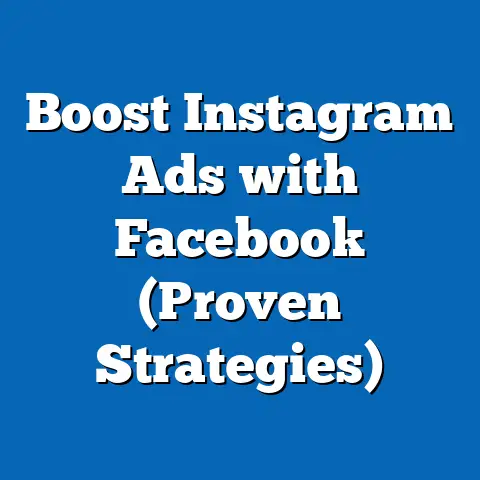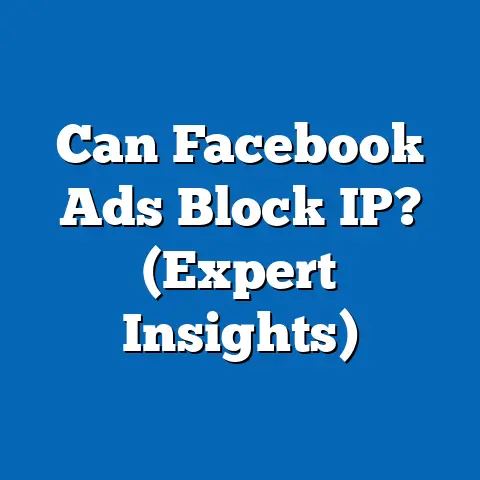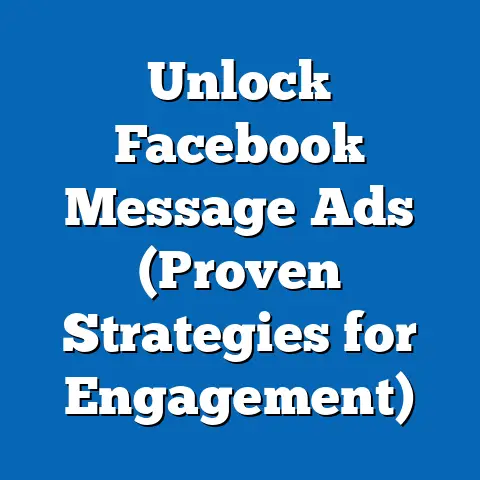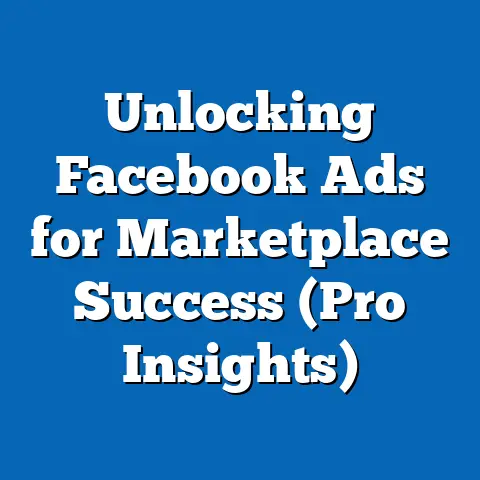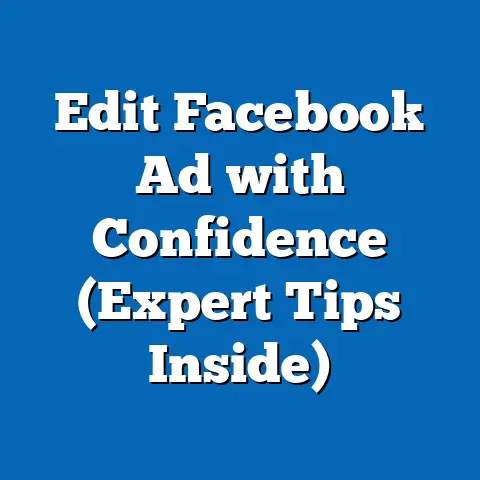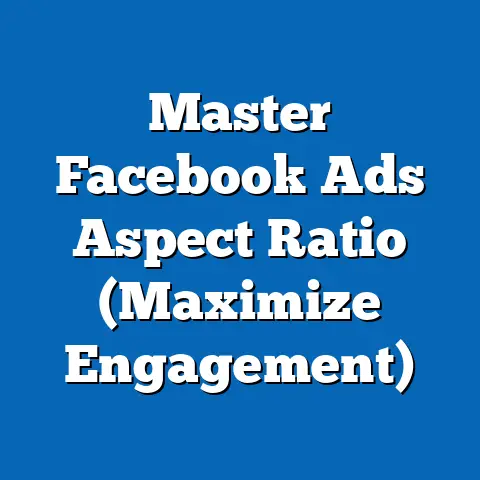Boost Engagement with Facebook Group Ads (Expert Strategies)
Remember the good old days when connecting with people was as easy as knocking on their door? Nowadays, it feels like everyone’s locked behind a digital wall, scrolling endlessly through feeds. I once tried to reconnect with some college buddies through a Facebook group, and it felt like shouting into the void. I was getting more interaction from what I suspected were bots than actual humans! It was then I realized that simply being on Facebook wasn’t enough; I needed a strategy, a way to break through the noise and truly engage. That’s where the power of Facebook Group Ads comes in.
In this article, I’m going to dive deep into the world of Facebook Group Ads and show you how they can transform your engagement strategy. Forget the generic, scattershot approach. We’re talking laser-focused tactics to build real connections within thriving online communities.
Section 1: Understanding Facebook Groups
What Are Facebook Groups?
Facebook Groups are essentially online communities built around shared interests, hobbies, locations, or goals. Think of them as digital versions of your local book club, hiking group, or even just a bunch of folks who love a particular brand of coffee. Unlike Facebook Pages, which are designed for businesses and public figures to broadcast information, Groups are designed for interaction and conversation. Members can post, comment, share, and participate in discussions, creating a sense of belonging and camaraderie.
I’ve seen groups dedicated to everything from vintage record collecting to specific breeds of dogs. The beauty of groups is their focused nature. People join them because they’re genuinely interested in the topic, making them a highly receptive audience.
The Rise of Facebook Group Ads
Facebook advertising has evolved dramatically over the years. Initially, it was all about reaching a broad audience based on basic demographics and interests. But as the platform matured, so did the targeting options. We went from simple age and location filters to incredibly granular targeting based on behaviors, life events, and even purchase history.
The introduction of Facebook Group Ads was a game-changer. It allowed advertisers to tap into the power of these niche communities and deliver highly relevant messages to engaged audiences. Instead of hoping your ad reaches someone interested in your product or service, you can target people who are already actively participating in discussions about it.
According to recent statistics, ads placed within Facebook Groups have a click-through rate (CTR) that’s up to 3x higher than traditional Facebook ads. (Source: Social Media Examiner). This is because group members are more likely to trust and engage with content that feels authentic and relevant to their shared interests.
Why Engagement Matters
Engagement is the lifeblood of any successful marketing strategy. It’s not enough to simply get your message in front of people; you need to capture their attention, spark their interest, and inspire them to take action. Think of it like this: imagine you’re hosting a party. If everyone is standing around silently, staring at their phones, it’s a pretty dull affair. But if people are laughing, talking, and actively participating, the party is a hit!
The same principle applies to your Facebook marketing efforts. Engagement translates to:
- Increased Brand Awareness: When people interact with your content (likes, comments, shares), it expands your reach organically.
- Improved Brand Loyalty: Engaging with your audience builds trust and fosters a sense of connection.
- Higher Conversion Rates: Engaged customers are more likely to buy your products or services.
- Valuable Feedback: Engagement provides insights into what your audience wants and needs.
Takeaway: Facebook Groups offer a powerful opportunity to connect with highly engaged audiences. By understanding the dynamics of these communities and crafting relevant ads, you can significantly boost your marketing results.
Section 2: Setting Up for Success
Identifying Your Target Audience
Before you start creating Facebook Group Ads, you need to have a clear understanding of who you’re trying to reach. This means going beyond basic demographics and digging into their interests, behaviors, and motivations.
Here are some key questions to ask yourself:
- Who are my ideal customers? What are their demographics (age, gender, location, income)?
- What are their interests and hobbies? What do they enjoy doing in their free time?
- What are their pain points and challenges? What problems are they trying to solve?
- What kind of language do they use? How do they communicate with each other?
- What are their values and beliefs? What’s important to them?
Facebook Insights is an invaluable tool for gathering this information. If you already have a Facebook Page, you can use Insights to analyze the demographics and interests of your followers. You can also use Audience Insights to explore potential audiences based on various criteria.
I once worked with a client who was selling organic baby food. Initially, they were targeting all parents on Facebook. But by using Audience Insights, we discovered that their ideal customers were actually eco-conscious moms who were active in parenting groups focused on natural living and sustainable practices. This insight allowed us to refine our targeting and significantly improve our ad performance.
Choosing the Right Groups
Once you have a clear understanding of your target audience, you need to identify the Facebook Groups where they’re most likely to be active. Not all groups are created equal. Some are thriving communities with high levels of engagement, while others are ghost towns with little to no activity.
Here are some factors to consider when choosing the right groups:
- Group Size: A larger group doesn’t necessarily mean better results. Focus on groups with a healthy balance of size and engagement.
- Engagement Levels: Look for groups where members are actively posting, commenting, and sharing content.
- Audience Demographics: Ensure that the group’s demographics align with your target audience.
- Group Rules: Familiarize yourself with the group’s rules and guidelines before posting any ads.
- Relevance: Choose groups that are directly related to your product or service, or at least relevant to your target audience’s interests.
I recommend spending some time browsing the groups you’re considering joining. Get a feel for the community, observe the types of conversations that are taking place, and see how members interact with each other. This will help you determine whether the group is a good fit for your ads.
Crafting Compelling Group Ads
Creating effective Facebook Group Ads requires a different approach than traditional Facebook ads. You need to be more authentic, more engaging, and more relevant to the specific interests of the group members.
Here are some tips for crafting compelling group ads:
- Use Authentic Language: Speak to group members in their own language. Avoid using overly formal or salesy language.
- Focus on Value: Highlight the benefits of your product or service, and explain how it can help group members solve their problems or achieve their goals.
- Include Visuals: Use high-quality images or videos that are relevant to the group’s interests.
- Ask Questions: Pose questions that encourage group members to participate in the conversation.
- Offer Exclusive Deals: Provide exclusive discounts or offers for group members to incentivize them to take action.
- Use a Clear Call-to-Action: Tell group members exactly what you want them to do (e.g., “Visit our website,” “Join our mailing list,” “Download our free guide”).
When I’m writing ad copy for Facebook Groups, I always try to think like a member of the group. What would I find interesting? What would make me want to click on an ad? By putting yourself in the shoes of your target audience, you can create ads that resonate with them and drive results.
Takeaway: Setting up for success with Facebook Group Ads requires a deep understanding of your target audience, careful selection of relevant groups, and the creation of compelling ad content that speaks directly to group members.
Section 3: Expert Strategies for Boosting Engagement
Leverage User-Generated Content
One of the most powerful ways to boost engagement in Facebook Groups is to leverage user-generated content (UGC). UGC is any content created by your customers or fans, such as reviews, testimonials, photos, or videos.
When people see that other customers are enjoying your product or service, they’re more likely to trust your brand and consider making a purchase. UGC also adds a layer of authenticity to your ads, making them feel less like traditional advertising and more like genuine recommendations.
Here are some ways to leverage UGC in your Facebook Group Ads:
- Ask for Reviews: Encourage your customers to leave reviews on your Facebook Page or website.
- Run Contests: Host contests where people can submit photos or videos using your product or service.
- Share Testimonials: Feature testimonials from satisfied customers in your ads.
- Repurpose Content: Turn customer photos or videos into short, engaging ads.
I worked with a local restaurant that was struggling to attract new customers. We decided to run a photo contest in a local foodies Facebook Group, asking members to submit photos of their favorite dishes at the restaurant. The response was overwhelming! We received hundreds of mouthwatering photos, which we then used in our Facebook Group Ads. The ads generated a significant increase in website traffic and reservations.
Create Exclusive Offers for Group Members
Everyone loves a good deal. Offering exclusive discounts or promotions to Facebook Group members is a great way to incentivize them to engage with your ads and take action.
Exclusive offers can create a sense of exclusivity and make group members feel like they’re part of a special community. This can lead to increased brand loyalty and higher conversion rates.
Here are some examples of exclusive offers you can create:
- Discount Codes: Provide a unique discount code that group members can use on your website.
- Free Shipping: Offer free shipping on orders placed by group members.
- Early Access: Give group members early access to new products or services.
- Bundled Deals: Create special bundled deals that are only available to group members.
When creating exclusive offers, make sure they’re truly valuable to your target audience. A small discount or a generic offer is unlikely to generate much excitement. Focus on creating offers that are tailored to the specific needs and interests of the group members.
Utilize Polls and Questions
Polls and questions are powerful tools for sparking engagement in Facebook Groups. They encourage group members to participate in the conversation and share their opinions.
When you include polls or questions in your Facebook Group Ads, you’re not just broadcasting information; you’re inviting people to interact with your brand. This can lead to increased brand awareness, improved brand loyalty, and valuable feedback.
Here are some tips for using polls and questions effectively:
- Keep it Simple: Make your polls and questions easy to understand and answer.
- Make it Relevant: Choose topics that are relevant to the group’s interests.
- Offer Multiple Choices: Provide a range of options to choose from.
- Encourage Discussion: Invite group members to share their thoughts and opinions in the comments.
I once ran a poll in a Facebook Group for travel enthusiasts, asking members about their favorite travel destinations. The poll generated hundreds of responses and sparked a lively discussion about travel tips and recommendations. We then used the results of the poll to create targeted ads promoting our travel agency’s services.
Incorporate Live Videos and Events
Live videos and events are a fantastic way to boost real-time engagement in Facebook Groups. They allow you to connect with your audience in a more personal and interactive way.
When you host a live video or event, you’re creating an opportunity for group members to ask questions, share their thoughts, and interact with your brand in real-time. This can lead to increased brand loyalty, improved customer satisfaction, and higher conversion rates.
Here are some ideas for incorporating live videos and events into your Facebook Group Ads:
- Product Demos: Showcase your products or services in action.
- Q&A Sessions: Answer questions from group members about your brand or industry.
- Behind-the-Scenes Tours: Give group members a glimpse into your company culture.
- Expert Interviews: Interview industry experts on topics that are relevant to the group’s interests.
When promoting live videos and events in your Facebook Group Ads, make sure to highlight the benefits of attending. Explain what group members will learn or gain by participating.
Engage with Comments and Feedback
Engaging with comments and feedback on your Facebook Group Ads is crucial for fostering a sense of community and encouraging further interaction.
When you respond to comments and feedback, you’re showing group members that you value their opinions and that you’re listening to what they have to say. This can lead to increased brand loyalty, improved customer satisfaction, and a more positive brand image.
Here are some best practices for engaging with comments and feedback:
- Respond Promptly: Try to respond to comments and feedback as quickly as possible.
- Be Polite and Respectful: Treat all comments and feedback with respect, even if they’re negative.
- Answer Questions Thoroughly: Provide detailed answers to any questions that group members may have.
- Acknowledge Feedback: Thank group members for their feedback and let them know that you appreciate their input.
- Encourage Further Discussion: Invite group members to continue the conversation by asking follow-up questions or sharing their own experiences.
Takeaway: Boosting engagement in Facebook Groups requires a multi-faceted approach. By leveraging user-generated content, creating exclusive offers, utilizing polls and questions, incorporating live videos and events, and engaging with comments and feedback, you can build a thriving community around your brand and drive significant results.
Section 4: Measuring Success
Key Metrics to Track
You’ve put in the work to create engaging Facebook Group Ads, but how do you know if they’re actually working? The key is to track the right metrics and analyze the data to see what’s resonating with your audience and what’s not.
Here are some key metrics to track:
- Engagement Rate: This measures the percentage of people who saw your ad and interacted with it (likes, comments, shares). A higher engagement rate indicates that your ad is relevant and interesting to your target audience.
- Click-Through Rate (CTR): This measures the percentage of people who saw your ad and clicked on the link. A higher CTR indicates that your ad is compelling and encourages people to take action.
- Conversion Rate: This measures the percentage of people who clicked on your ad and completed a desired action (e.g., making a purchase, signing up for a newsletter). A higher conversion rate indicates that your ad is effectively driving results.
- Cost Per Click (CPC): This measures the average cost you pay each time someone clicks on your ad. Lowering your CPC can help you maximize your budget and reach more people.
- Reach: This measures the number of unique people who saw your ad. Increasing your reach can help you expand your brand awareness and attract new customers.
- Frequency: This measures the average number of times each person saw your ad. It’s important to monitor your frequency to avoid ad fatigue, which can lead to decreased engagement.
- Group Member Growth: If your ad is aimed at growing your own Facebook Group, track the number of new members you’re gaining.
Analyzing Performance Data
Tracking metrics is only half the battle. You also need to analyze the data to identify trends, patterns, and areas for improvement.
Here are some questions to ask yourself when analyzing your performance data:
- Which ads are performing the best? What are the common elements of your most successful ads?
- Which ads are underperforming? What can you do to improve their performance?
- Which groups are generating the most engagement? Are there any common characteristics of these groups?
- What types of content are resonating with your audience? What topics are they most interested in?
- Are you reaching your target audience? Are the demographics of the people who are engaging with your ads aligned with your ideal customer profile?
Facebook Ads Manager provides a wealth of data that you can use to answer these questions. You can create custom reports, track key metrics, and segment your data to gain deeper insights into your ad performance.
I recommend setting up a regular reporting schedule to track your progress and identify areas for improvement. This will help you stay on top of your ad performance and make data-driven decisions.
Case Studies
To illustrate the power of Facebook Group Ads, let’s take a look at a couple of real-world examples:
- Example 1: A Local Gym A local gym wanted to attract new members. They created a Facebook Group Ad targeting members of local fitness groups, offering a free one-week trial membership. The ad generated a significant increase in trial memberships and ultimately led to a surge in new paying members.
- Example 2: An Online Clothing Boutique An online clothing boutique wanted to increase sales. They created a Facebook Group Ad targeting members of fashion groups, offering an exclusive discount code for group members. The ad generated a significant increase in website traffic and sales.
These case studies demonstrate that Facebook Group Ads can be a highly effective way to boost engagement, attract new customers, and drive results.
Takeaway: Measuring the success of your Facebook Group Ads is essential for optimizing your campaigns and maximizing your ROI. By tracking key metrics, analyzing performance data, and learning from case studies, you can continuously improve your ad performance and achieve your marketing goals.
Section 5: Common Pitfalls and How to Avoid Them
Ignoring Group Rules
One of the biggest mistakes you can make when advertising in Facebook Groups is ignoring the group rules. Each group has its own set of rules and guidelines that members are expected to follow. Violating these rules can lead to negative engagement, such as members reporting your ad or leaving negative comments. In severe cases, you could even be banned from the group.
Before posting any ads in a Facebook Group, take the time to familiarize yourself with the group rules. You can usually find them in the “About” section of the group.
Here are some common group rules to be aware of:
- No Self-Promotion: Some groups prohibit self-promotion altogether.
- No Spam: Avoid posting overly promotional or irrelevant content.
- Stay on Topic: Keep your ads relevant to the group’s interests.
- Be Respectful: Treat all members with respect.
- Follow the Posting Guidelines: Adhere to any specific posting guidelines that the group may have.
Over-Promotion
Even if a group allows self-promotion, it’s important to avoid over-promoting your products or services. Excessive promotion can alienate group members and make them feel like you’re just trying to sell them something.
Instead of focusing solely on selling, try to provide value to the group members. Share helpful tips, answer questions, and participate in discussions. By building trust and establishing yourself as a valuable member of the community, you’ll be more likely to attract customers.
I recommend following the 80/20 rule: 80% of your content should be valuable and informative, and 20% can be promotional.
Failing to Adapt
Facebook Groups are dynamic communities. Group dynamics and member interests can change over time. It’s important to be flexible and adapt your strategies based on these changes.
Pay attention to the types of content that are resonating with the group members. Are they more interested in videos, articles, or polls? Are there any specific topics that they’re particularly passionate about?
By monitoring the group’s activity and adjusting your strategies accordingly, you can ensure that your ads remain relevant and engaging.
Takeaway: Avoiding common pitfalls is just as important as implementing effective strategies. By respecting group rules, avoiding over-promotion, and adapting to changing dynamics, you can maximize your chances of success with Facebook Group Ads.
Conclusion
In today’s digital landscape, connecting with your target audience requires more than just a presence on social media—it demands a strategic approach to engagement. Facebook Group Ads offer a unique opportunity to tap into niche communities and foster meaningful connections with potential customers. By understanding the dynamics of these groups, crafting compelling ad content, and consistently measuring your results, you can unlock the full potential of Facebook Group Ads.
Remember Bob from the beginning? Well, after implementing these strategies, Bob not only reconnected with his college buddies but also became a respected voice within the group, even leading a few discussions himself. He proved that with the right approach, even in the vast digital world, genuine engagement is possible. So, go ahead, give these expert strategies a try, and watch your engagement soar!

